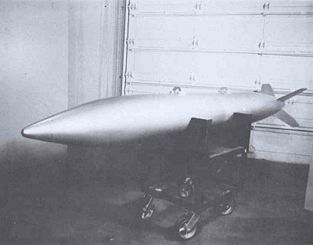- Mark 11 nuclear bomb
-
The Mark 11 nuclear bomb was an American nuclear bomb developed from the earlier Mark 8 nuclear bomb in the mid 1950s. Like the Mark 8, the Mark 11 was an earth-penetrating weapon, also known as a Nuclear bunker buster bomb.
Description
As with the Mark 8, the Mark 11 was a Gun-type nuclear bomb (see also Nuclear weapon design#Gun-type assembly weapon). It used a fixed large target assembly of highly enriched uranium or HEU, a gun like barrel, and a powder charge and uranium bullet or projectile fired up the barrel into the target.
The Mark 11 was first produced in 1956, and was in service until 1960. A total of 40 were produced, replacing but not expanding the quantity of Mark 8 bombs. It was 14 inches in diameter and 147 inches long, with a weight of 3,210 to 3,500 pounds. Yield was reportedly the same as the Mark 8, 25 to 30 kilotons.
The two bombs reportedly used the same basic fissile weapon design, but the Mark 11 had a much more modern external casing designed to penetrate further and more reliably into the ground. The Mark 8 had a flat nose, much like a torpedo. The Mark 11 nose was a pointed ogive shape.
See also
External links
- Allbombs.html list of all US nuclear warheads at nuclearweaponarchive.org
Categories:- Cold War nuclear bombs of the United States
- Gun-type nuclear bombs
Wikimedia Foundation. 2010.

